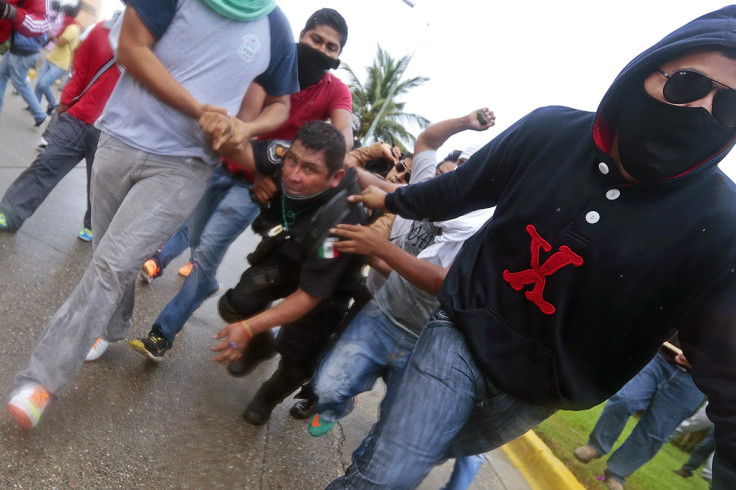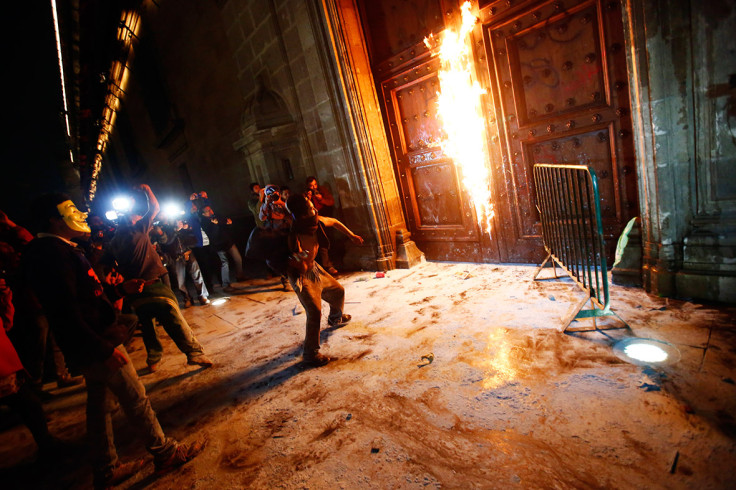Mexico Student Protests Evolve into Anti-Government Movement

Outraged protests at the Mexican government's handling of the disappearance of 43 student teachers in the south of the country have mushroomed into massive anti-government rallies, that left 16 police officers in Acapulco injured after clashes between protesters and authorities.
The violent escalation started after Mexico's attorney general Jesus Murillo Karam announced last Friday that a large group of young people were killed on the night of the student's arrest and disappearance (26 September) in a municipal garbage dump in Cocula, in the southern state of Guerrero. Jesus Murillo added that the victims were burned on a pyre for 14 hours making it almost impossible for authorities to identify the bodies.
#YaMeCanse

But it was his last sentence that enraged people on social media, who seized the opportunity to publicly criticise the government. "No more questions. I'm tired of this," he said. The hashtag #YaMeCanse (I'm tired) started trending on Twitter soon afterwards, along with #Ayotzinapa the place where the students were enrolled in teacher training before they went missing.
Critics and parents of the victims accused the government of trying to shut down the case, the investigation into which is based on the confessions of three drug cartel hit men. To further complicate the picture there's the usual security crisis engulfing parts of Mexico, where drug gangs have taken over municipal governments and in some cases are working side by side with local officers.
In the latest case, the students, enrolled in the Centre for economic teaching and research at the Raul Isidro Burgos college of Normal de Ayotzinapa, were shot at while travelling in four buses by police officers acting under the orders of Iguala mayor Jose Luis Abarca. According to reports, Abarca did not want the students coming into the town to disrupt a speech by his wife, Maria de Los Angeles Pineda.
Six students were killed on the spot while others were handed over to the Guerreros Unidos drug gang. Abarca and his wife were arrested in Mexico City earlier this month.
"Our government is so closely tied to criminal organisations that it's hard to tell where one ends and the other begins," Natassja Ybarra Klor, Mexico City-based writer who took part to the protest told IBTimes UK.
"Anybody with a voice strong and loud enough to be heard is immediately intimidated by either or both, and in extreme cases, if they're courageous enough to carry on, they're incarcerated or executed."
"I think the situation is best defined by this horrific scenario: after ordering police officers to 'get rid' of the protesting students that were interrupting his wife's political act, Abarca, mayor of Iguala, danced," she continued. "As they were brutally murdered (at least in the version presented by the PGR) and burned to ashes, he and his wife danced."
Abarca has been accused in the past of direct participation in torture and murders of activists.
Challenging the government

Last Saturday, tens of thousands of people marched in Mexico City, the capital. The demonstration, largely peaceful, took a wrong turn when 20 protesters briefly set fire to the door of the National Palace, used for official ceremonies by President Enrique Peña Nieto
Our government is so closely tied to criminal organizations that it's hard to tell where one ends and the other begins
However, activists point the finger at the government, claiming provocateurs were in place to scare the public and divert the attention to the real issues. Authorities allegedly did nothing to stop the attack.
"It's hard to pinpoint whether the 'looters' are just angry citizens, a handful of punks or government thugs. Either way, they've managed to divert attention from what really counts," said Natassja Ybarra Klor.
She claims that the protest movement has moved on from its students base to encompass other social classes and generations.
"Every protest I go to, I see mothers, fathers, children, artists, unions, universities, all types of ordinary citizens and even catholic priests. It's a full force, plural and diverse social movement. And as we work past our pain and turn our anger into positive propositions I believe that yes, we are challenging the government."
© Copyright IBTimes 2024. All rights reserved.






